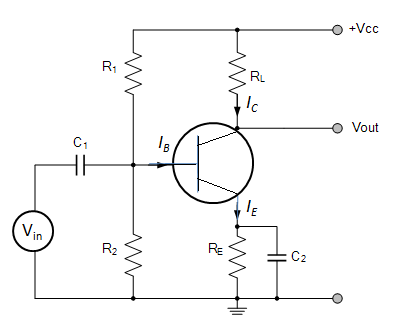
For a transistor amplifier, the voltage gain
A. Remains constant for all frequencies
B. Is high at low and high frequencies and constant in the middle range frequencies.
C. Is low at low and high frequencies and constant in the middle range frequencies.
D. None of the above.
Answer
465.6k+ views
Hint: Recall the circuit diagram for the transistor working as an amplifier. We know that capacitors oppose the current flow. Recall the formula for reactance of the capacitor and use this formula to answer this question.
Complete step by step solution:
We know that a transistor is used for increasing the amplitude of the alternating signal. We can draw the amplifier circuit as an amplifier.

We know that the voltage gain is defined as the ratio of change in output voltage to the change in input voltage. The voltage gain of the transistor amplifier is given as,
\[{A_v} = \dfrac{{\Delta {V_O}}}{{\Delta {V_I}}}\] …… (1)
Here, \[\Delta {V_O}\] is the change in output voltage and \[\Delta {V_I}\] is the change in input voltage.
We know that the voltage gain of the amplifier changes with frequency because the reactance of the coupling capacitors \[{C_1}\] and \[{C_2}\] changes with frequency as per the following equation.
\[{X_C} = \dfrac{1}{{2\pi fC}}\]
Here, f is the frequency and C is the capacitance.
At low frequencies, the reactance \[{X_C}\] of the coupling capacitor \[{C_2}\] becomes high. Therefore, the output signal flowing through the capacitor decreases effectively. Since the output voltage decreases, from equation (1), the voltage gain also decreases at low frequencies.
At high frequencies, the reactance of the coupling capacitor \[{C_2}\] becomes low, and it will allow the maximum flow of signal through it. But this will increase the loading effect of the amplifier and eventually the transistor starts to reduce the signal. Also, at high frequencies, the reactance of the coupling capacitor \[{C_1}\] is very small. Therefore, the base current will increase. We know the relation, the current amplification factor \[\beta = \dfrac{{{I_C}}}{{{I_B}}}\], where, \[{I_C}\] is the collector current and \[{I_B}\] is the base current. When the base current increases the amplification factor decreases. Therefore, the voltage gain of the transistor amplifier decreases at high frequencies.
At mid range frequencies, the coupling capacitor \[{C_2}\] provides constant reactance and in turn, the voltage gain remains constant.
So, the correct answer is “Option C”.
Note:
To answer these types of questions, students should remember the formula for voltage gain, reactance of capacitor and current amplification factor. Most of the time, such types of questions can be answered at the first glance at the proper formula. In the circuit diagram, \[{V_{in}}\] is the AC supply whereas \[{V_{CC}}\] is the DC supply. Note that capacitors oppose only AC signals and not DC signals.
Complete step by step solution:
We know that a transistor is used for increasing the amplitude of the alternating signal. We can draw the amplifier circuit as an amplifier.

We know that the voltage gain is defined as the ratio of change in output voltage to the change in input voltage. The voltage gain of the transistor amplifier is given as,
\[{A_v} = \dfrac{{\Delta {V_O}}}{{\Delta {V_I}}}\] …… (1)
Here, \[\Delta {V_O}\] is the change in output voltage and \[\Delta {V_I}\] is the change in input voltage.
We know that the voltage gain of the amplifier changes with frequency because the reactance of the coupling capacitors \[{C_1}\] and \[{C_2}\] changes with frequency as per the following equation.
\[{X_C} = \dfrac{1}{{2\pi fC}}\]
Here, f is the frequency and C is the capacitance.
At low frequencies, the reactance \[{X_C}\] of the coupling capacitor \[{C_2}\] becomes high. Therefore, the output signal flowing through the capacitor decreases effectively. Since the output voltage decreases, from equation (1), the voltage gain also decreases at low frequencies.
At high frequencies, the reactance of the coupling capacitor \[{C_2}\] becomes low, and it will allow the maximum flow of signal through it. But this will increase the loading effect of the amplifier and eventually the transistor starts to reduce the signal. Also, at high frequencies, the reactance of the coupling capacitor \[{C_1}\] is very small. Therefore, the base current will increase. We know the relation, the current amplification factor \[\beta = \dfrac{{{I_C}}}{{{I_B}}}\], where, \[{I_C}\] is the collector current and \[{I_B}\] is the base current. When the base current increases the amplification factor decreases. Therefore, the voltage gain of the transistor amplifier decreases at high frequencies.
At mid range frequencies, the coupling capacitor \[{C_2}\] provides constant reactance and in turn, the voltage gain remains constant.
So, the correct answer is “Option C”.
Note:
To answer these types of questions, students should remember the formula for voltage gain, reactance of capacitor and current amplification factor. Most of the time, such types of questions can be answered at the first glance at the proper formula. In the circuit diagram, \[{V_{in}}\] is the AC supply whereas \[{V_{CC}}\] is the DC supply. Note that capacitors oppose only AC signals and not DC signals.
Recently Updated Pages
Master Class 11 Accountancy: Engaging Questions & Answers for Success

Express the following as a fraction and simplify a class 7 maths CBSE

The length and width of a rectangle are in ratio of class 7 maths CBSE

The ratio of the income to the expenditure of a family class 7 maths CBSE

How do you write 025 million in scientific notatio class 7 maths CBSE

How do you convert 295 meters per second to kilometers class 7 maths CBSE

Trending doubts
Which are the Top 10 Largest Countries of the World?

Differentiate between homogeneous and heterogeneous class 12 chemistry CBSE

What is a transformer Explain the principle construction class 12 physics CBSE

Draw a labelled sketch of the human eye class 12 physics CBSE

What is the Full Form of PVC, PET, HDPE, LDPE, PP and PS ?

How much time does it take to bleed after eating p class 12 biology CBSE




